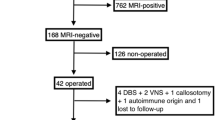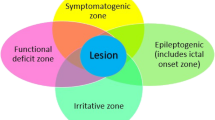Abstract
Intractable drug-resistant magnetic resonance imaging (MRI) negative epilepsy in one of the complicated issues in neurology. Epilepsy surgery is beneficial treatment of intractable seizures, but precise localization of epileptogenic zone is a major concern. Thirty-four MRI negative drug-resistant epilepsy patients underwent video electroencephalography (EEG), positron emission tomography (PET) scan, and voxel-based morphometry (VBM) MRI from 2014 to 2019. Then, the findings of PET scan and VBM were compared with semiology and long-term electrophysiology. Cohen’s kappa-coefficient (k) test was utilized to measure the agreement between our modalities. Among 34 patients with age ranging from 8 to 49 (mean: 29.00 ± standard deviation: 10.35), 19 were male (55.9%) and 15 were female (44.1%). Twenty-one patients (61.76%) had right temporal, 12 patients (35.3%) had left and one patient had bilateral temporal ictal focus according to video EEG. Inter-rater agreement analysis showed that the kappa index between video EEG and PET scan was of almost acceptable (more than 0.4) and there was poor agreement between video EEG and VBM (kappa index = 0.099). PET is highly concordant with video EEG in temporal lobe epilepsy (TLE) and has a considerable agreement in localizing epileptogenic zone while VBM is less.




Similar content being viewed by others
Data availability
Data is not published but it is available from the corresponding author.
References
GBDE Collaborators (2019) Global, regional, and national burden of epilepsy, 1990–2016: a systematic analysis for the Global Burden of Disease Study 2016. Lancet Neurol 18(4):357–375
Wiebe S (2006) Burden of intractable epilepsy. Adv Neurol 97:1–4
Tellez-Zenteno JF, Ronquillo LH, Wiebe S (2005) Sudden unexpected death in epilepsy: evidence-based analysis of incidence and risk factors. Epilepsy Res 65(1–2):101–115
Spencer SS et al (2003) Initial outcomes in the multicenter study of epilepsy surgery. Neurology 61(12):1680–1685
Lee SK et al (2005) Surgical outcome and prognostic factors of cryptogenic neocortical epilepsy. Ann Neurol 58(4):525–532
Bien CG et al (2009) Characteristics and surgical outcomes of patients with refractory magnetic resonance imaging-negative epilepsies. Arch Neurol 66(12):1491–1499
Jeha LE et al (2007) Surgical outcome and prognostic factors of frontal lobe epilepsy surgery. Brain 130(Pt 2):574–584
Tellez-Zenteno JF et al (2010) Surgical outcomes in lesional and non-lesional epilepsy: a systematic review and meta-analysis. Epilepsy Res 89(2–3):310–318
Burneo JG et al (2015) The utility of positron emission tomography in epilepsy. Can J Neurol Sci 42(6):360–371
Zhang J et al (2014) Multimodal neuroimaging in presurgical evaluation of drug-resistant epilepsy. Neuroimage Clin 4:35–44
Shah AK, Mittal S (2014) Evaluation of magnetic resonance imaging-negative drug-resistant epilepsy. Ann Indian Acad Neurol 17(Suppl 1):S80–S88
Focke NK et al (2009) Automated normalized FLAIR imaging in MRI-negative patients with refractory focal epilepsy. Epilepsia 50(6):1484–1490
Riney CJ et al (2012) Voxel based morphometry of FLAIR MRI in children with intractable focal epilepsy: implications for surgical intervention. Eur J Radiol 81(6):1299–1305
Pail M et al (2012) The role of voxel-based morphometry in the detection of cortical dysplasia within the temporal pole in patients with intractable mesial temporal lobe epilepsy. Epilepsia 53(6):1004–1012
Wang W et al (2019) Voxel-based morphometric magnetic resonance imaging postprocessing in non-lesional pediatric epilepsy patients using pediatric normal databases. Eur J Neurol 26(7):969-e71
Ingvar DH (1984) Epilepsy related to cerebral blood flow and metabolism. Acta Psychiatr Scand Suppl 313:21–6
Willmann O et al (2007) The contribution of 18F-FDG PET in preoperative epilepsy surgery evaluation for patients with temporal lobe epilepsy: a meta-analysis. Seizure 16(6):509–20
Eissa AA, Bahnasy W, Salama AA, Eldin EA, Fayed H (2019) Long-term EEG monitoring and positron emission tomography in evaluating patients with drug-resistant epilepsy. Egypt J Neurol Psychiatry Neurosurg 55:1–7. https://doi.org/10.1186/s41983-019-0112-9
Helveston W et al (1996) Intractable temporal lobe epilepsy: comparison of positron emission tomography with qualitative and quantitative MR. AJNR Am J Neuroradiol 17(8):1515–21
Jaisani Z, Miletich RS, Ramanathan M, Weinstock AL (2020) Clinical FDG-PET findings in patients with temporal lobe epilepsy: concordance with EEG and MRI. J Neuroimaging 30:119–125. https://doi.org/10.1111/jon.12671
da Silva EA et al (1997) Identification of frontal lobe epileptic foci in children using positron emission tomography. Epilepsia 38(11):1198–208
Kim YK et al (2002) (18)F-FDG PET in localization of frontal lobe epilepsy: comparison of visual and SPM analysis. J Nucl Med 43(9):1167–74
Muhlhofer W et al (2017) MRI-negative temporal lobe epilepsy-what do we know? Epilepsia 58(5):727–742
Wang GB et al (2017) Dynamic contrast-enhanced magnetic resonance imaging (DCE-MRI) combined with positron emission tomography-computed tomography (PET-CT) and video-electroencephalography (VEEG) have excellent diagnostic value in preoperative localization of epileptic foci in children with epilepsy. Med Sci Monit 23:1–10
Doelken MT et al (2012) Multimodality approach in cryptogenic epilepsy with focus on morphometric 3T MRI. J Neuroradiol 39(2):87–96
Salmenpera TM et al (2007) Evaluation of quantitative magnetic resonance imaging contrasts in MRI-negative refractory focal epilepsy. Epilepsia 48(2):229–37
Funding
This research study is not sponsored by any organization.
Author information
Authors and Affiliations
Corresponding author
Ethics declarations
Conflict of interest
The authors certify that they have NO affiliations with or involvement in any organization or entity with any financial interest in the subject and material discussed in this manuscript.
Ethical approval
The informed consent of all participants for using their information was obtained under the supervision of the Ethics Committee of Shahid Beheshti University of Medical Sciences. They were also ensured about the confidentiality of their information.
Additional information
Publisher's Note
Springer Nature remains neutral with regard to jurisdictional claims in published maps and institutional affiliations.
Rights and permissions
About this article
Cite this article
Habibabadi, J.M., Doroudinia, A., Koma, A.Y. et al. Comparison of non-invasive imaging modalities in presurgical evaluation of temporal lobe epilepsy patients: a multicenter study. Acta Neurol Belg 121, 1815–1821 (2021). https://doi.org/10.1007/s13760-020-01550-9
Received:
Accepted:
Published:
Issue Date:
DOI: https://doi.org/10.1007/s13760-020-01550-9




